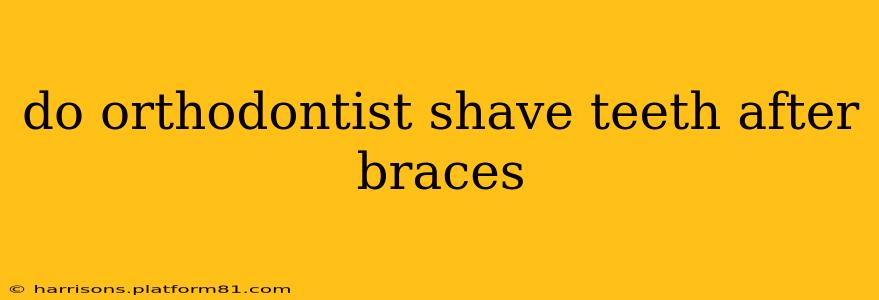Many patients wonder if their teeth will be shaved down after their braces are removed. The short answer is: generally, no, orthodontists don't routinely "shave" teeth after braces. However, there are some situations where minor adjustments might be necessary, and understanding the process is crucial. This article will clarify the misconceptions surrounding this procedure and explore the various steps involved in achieving a straight, healthy smile after orthodontic treatment.
What Happens After Braces Are Removed?
Once your braces are removed, your orthodontist will have completed the major alignment of your teeth. The next step is crucial for maintaining the results of the orthodontic treatment. This often involves:
- Bond removal: The brackets and any remaining adhesive are carefully removed from your teeth.
- Cleaning: Your teeth are thoroughly cleaned to remove any leftover cement or plaque that may have accumulated during treatment.
- Polishing: The surfaces of your teeth are polished to remove any roughness left by the brackets and adhesive. This process smooths the enamel, leaving your teeth feeling comfortable.
- Retainer Fitting: This is the most crucial step. Retainers, either removable or fixed (bonded to the back of your teeth), are fitted to maintain the new position of your teeth. Without retainers, your teeth can shift back to their original position.
Why the "Shaving" Misconception?
The idea that teeth are "shaved" often stems from a misunderstanding of the process. While some minor enamel reshaping might occur in specific cases, it's not the same as shaving down significant portions of the tooth structure. The procedures involved are typically much more subtle and precise.
Interproximal Reduction (IPR)
In some cases, orthodontists may perform interproximal reduction (IPR). This involves carefully removing a tiny amount of enamel from between the teeth. It's a precise procedure, only removing a fraction of a millimeter, and it's done to create space for crowded teeth to align properly during orthodontic treatment, not after. It's not considered "shaving" in the traditional sense.
Enamel Shaping (Slight Adjustments)
In rare instances, after braces removal, very minor enamel shaping may be necessary to improve the overall aesthetic outcome. This might involve smoothing out slight irregularities or addressing minor imperfections that are not noticeable unless specifically looked for. This is not a common practice and is only done when absolutely necessary to achieve the optimal result.
Do I Need to Worry About My Teeth Being Shaved?
Most patients do not need to worry about their teeth being "shaved" after braces. The vast majority of orthodontists prioritize preserving as much tooth enamel as possible. If your orthodontist believes IPR or any enamel shaping is necessary, they will thoroughly explain the procedure, its benefits, and any potential risks before proceeding. Open communication with your orthodontist is key.
What if My Teeth are Still Crowded After Braces?
If you find your teeth are still crowded or misaligned after braces removal, do not attempt to self-treat. Schedule an appointment with your orthodontist immediately. There might be underlying issues that require further evaluation and treatment.
Choosing the Right Orthodontist
Selecting an experienced and qualified orthodontist is crucial for ensuring a successful outcome and minimizing the risk of any unnecessary procedures. Always ask questions and seek a second opinion if you have any concerns about your treatment plan.
